Co-Effects of Hydrological Conditions and Industrial Activities on the Distribution of Heavy Metal Pollution in Taipu River, China
Abstract
:1. Introduction
2. Materials and Methods
2.1. Study Area
2.2. Sample Collection and Analytical Methods
2.2.1. Sample Collection and Pretreatment
2.2.2. Analytical Methods
2.3. Geo-Accumulation Index
2.4. Source Identification and Apportionments
2.4.1. Correlation Analysis
2.4.2. Positive Matrix Factorization Model
2.5. Data Analysis
3. Results
3.1. Heavy Metal Concentrations in Sediment
3.2. Heavy Metal Distribution Characteristics
3.2.1. Temporal Distribution of Heavy Metals
3.2.2. Spatial Distribution of Heavy Metals
3.3. Source Apportionment of Heavy Metals
4. Discussion
4.1. Influence of Hydrological Conditions on Heavy Metals
4.2. Influence of Industrial Activities on Heavy Metals
5. Conclusions
Supplementary Materials
Author Contributions
Funding
Institutional Review Board Statement
Informed Consent Statement
Data Availability Statement
Acknowledgments
Conflicts of Interest
References
- Gall, J.E.; Boyd, R.S.; Rajakaruna, N. Transfer of heavy metals through terrestrial food webs: A review. Environ. Monit. Assess. 2015, 187, 201. [Google Scholar] [CrossRef] [PubMed]
- An, Q.; Wu, Y.; Wang, J.; Li, Z. Assessment of dissolved heavy metal in the Yangtze River estuary and its adjacent sea, China. Environ. Monit. Assess. 2010, 164, 173–187. [Google Scholar] [CrossRef] [PubMed]
- Chen, R.; Chen, H.; Song, L.; Yao, Z.; Meng, F.; Teng, Y. Characterization and source apportionment of heavy metals in the sediments of Lake Tai (China) and its surrounding soils. Sci. Total Environ. 2019, 694, 133819. [Google Scholar] [CrossRef] [PubMed]
- Chen, R.; Zhang, Q.; Chen, H.; Yue, W.; Teng, Y. Source apportionment of heavy metals in sediments and soils in an interconnected river-soil system based on a composite fingerprint screening approach. J. Hazard. Mater. 2021, 411, 125125. [Google Scholar] [CrossRef] [PubMed]
- Morelli, G.; Gasparon, M.; Fierro, D.; Hu, W.-P.; Zawadzki, A. Historical trends in trace metal and sediment accumulation in intertidal sediments of Moreton Bay, southeast Queensland, Australia. Chem. Geol. 2012, 300, 152–164. [Google Scholar] [CrossRef]
- Cicchella, D.; Albanese, S.; De Vivo, B.; Dinelli, E.; Giaccio, L.; Lima, A.; Valera, P. Trace elements and ions in Italian bottled mineral waters: Identification of anomalous values and human health related effects. J. Geochem. Explor. 2010, 107, 336–349. [Google Scholar] [CrossRef]
- Dinelli, E.; Lima, A.; De Vivo, B.; Albanese, S.; Cicchella, D.; Valera, P. Hydrogeochemical analysis on Italian bottled mineral waters: Effects of geology. J. Geochem. Explor. 2010, 107, 317–335. [Google Scholar] [CrossRef]
- Dinelli, E.; Lima, A.; Albanese, S.; Birke, M.; Cicchella, D.; Giaccio, L.; Valera, P.; De Vivo, B. Comparative study between bottled mineral and tap water in Italy. J. Geochem. Explor. 2012, 112, 368–389. [Google Scholar] [CrossRef]
- He, M.; Wang, N.; Long, X.; Zhang, C.; Ma, C.; Zhong, Q.; Wang, A.; Wang, Y.; Pervaiz, A.; Shan, J. Antimony speciation in the environment: Recent advances in understanding the biogeochemical processes and ecological effects. J. Environ. Sci. 2019, 75, 14–39. [Google Scholar] [CrossRef]
- Herath, I.; Vithanage, M.; Bundschuh, J. Antimony as a global dilemma: Geochemistry, mobility, fate and transport. Environ. Pollut. 2017, 223, 545–559. [Google Scholar] [CrossRef]
- Feng, C.; Zhao, S.; Wang, D.; Niu, J.; Shen, Z. Sedimentary records of metal speciation in the Yangtze Estuary: Role of hydrological events. Chemosphere 2014, 107, 415–422. [Google Scholar] [CrossRef] [PubMed]
- Bing, H.; Zhou, J.; Wu, Y.; Wang, X.; Sun, H.; Li, R. Current state, sources, and potential risk of heavy metals in sediments of Three Gorges Reservoir, China. Environ. Pollut. 2016, 214, 485–496. [Google Scholar] [CrossRef] [PubMed]
- Liu, M.; He, Y.; Baumann, Z.; Zhang, Q.; Jing, X.; Mason, R.P.; Xie, H.; Shen, H.; Chen, L.; Zhang, W.; et al. The impact of the Three Gorges Dam on the fate of metal contaminants across the river–ocean continuum. Water Res. 2020, 185, 116295. [Google Scholar] [CrossRef] [PubMed]
- Ye, C.; Butler, O.M.; Du, M.; Liu, W.; Zhang, Q. Spatio-temporal dynamics, drivers and potential sources of heavy metal pollution in riparian soils along a 600 kilometre stream gradient in Central China. Sci. Total Environ. 2019, 651, 1935–1945. [Google Scholar] [CrossRef] [PubMed]
- Chen, L.; Xiao, Y.; Li, Y.; Shen, Z. Construction of the hydrological condition-persistent organic pollutants relationship in the Yangtze River Estuary. J. Hazard. Mater. 2018, 360, 544–551. [Google Scholar] [CrossRef] [PubMed]
- Kaushik, A.; Kansal, A.; Santosh; Meena; Kumari, S.; Kaushik, C.P. Heavy metal contamination of river Yamuna, Haryana, India: Assessment by Metal Enrichment Factor of the Sediments. J. Hazard. Mater. 2009, 164, 265–270. [Google Scholar] [CrossRef]
- Khan, S.; Naushad, M.; Lima, E.C.; Zhang, S.; Shaheen, S.M.; Rinklebe, J. Global soil pollution by toxic elements: Current status and future perspectives on the risk assessment and remediation strategies—A review. J. Hazard. Mater. 2021, 417, 126039. [Google Scholar] [CrossRef]
- Li, Y.; Zhou, S.; Zhu, Q.; Li, B.; Wang, J.; Wang, C.; Chen, L.; Wu, S. One-century sedimentary record of heavy metal pollution in western Taihu Lake, China. Environ. Pollut. 2018, 240, 709–716. [Google Scholar] [CrossRef]
- Sun, J.; Zhao, M.; Huang, J.; Liu, Y.; Wu, Y.; Cai, B.; Han, Z.; Huang, H.; Fan, Z. Determination of priority control factors for the management of soil trace metal(loid)s based on source-oriented health risk assessment. J. Hazard. Mater. 2022, 423, 127116. [Google Scholar] [CrossRef]
- Chowdhury, S.; Mazumder, M.A.J.; Al-Attas, O.; Husain, T. Heavy metals in drinking water: Occurrences, implications, and future needs in developing countries. Sci. Total Environ. 2016, 569, 476–488. [Google Scholar] [CrossRef]
- Yang, S.; Wan, R.; Li, B. Hydrological connectivity research in Lake Taihu Basin: Status, progress and future challenges. J. Lake Sci. 2022, 34, 1055–1074. [Google Scholar] [CrossRef]
- Ma, N.; Li, M.; Wang, Y. Analysis on response of antimony pollution in Taipu River. Water Cons. Sci. Technol. Econ. 2018, 24, 19–22. [Google Scholar]
- Uddin, F. Environmental hazard in textile dyeing wastewater from local textile industry. Cellulose 2021, 28, 10715–10739. [Google Scholar] [CrossRef]
- Wang, M.; Lu, H.; Li, H.; Qian, X. Pollution level and ecological risk assessment of heavy metals in typical rivers of Taihu basin. Environ. Chem. 2016, 35, 2025–2035. [Google Scholar] [CrossRef]
- Yao, H.; Qian, X.; Gao, H.; Wang, Y.; Xia, B. Seasonal and Spatial Variations of Heavy Metals in Two Typical Chinese Rivers: Concentrations, Environmental Risks, and Possible Sources. Int. J. Environ. 2014, 11, 11860–11878. [Google Scholar] [CrossRef]
- Wang, Y.; Li, F.; Mao, L.; Chen, M.; Tao, H.; Li, J. Spatial distribution and pollution assessment of potentially toxic elements (PTEs) in surface sediments at the drinking water source channel of taipu river in China. Minerals 2021, 11, 1202. [Google Scholar] [CrossRef]
- Li, F.; Wang, Y.; Mao, L.; Tao, H.; Chen, M. Molybdenum background and pollution levels in the Taipu River, China. Environ. Chem. Lett. 2022, 20, 1009–1015. [Google Scholar] [CrossRef]
- Yan, G.; Mao, L.; Liu, S.; Mao, Y.; Ye, H.; Huang, T.; Li, F.; Chen, L. Enrichment and sources of trace metals in roadside soils in Shanghai, China: A case study of two urban/rural roads. Sci. Total Environ. 2018, 631–632, 942–950. [Google Scholar] [CrossRef]
- Liao, Q.; Liu, C.; Xu, Y.; Jin, Y. Geochemical baseline values for soil elements in Jiangsu Province. Geol. China 2011, 38, 1363–1378. [Google Scholar]
- Mao, L.; Mo, D.; Guo, Y.; Fu, Q.; Yang, J.; Jia, Y. Multivariate analysis of heavy metals in surface sediments from lower reaches of the Xiangjiang River, southern China. Environ. Earth Sci. 2013, 69, 765–771. [Google Scholar] [CrossRef]
- EPA, USEPA. EPA Positive Matrix Factorization (PMF) 5.0 Fundamentals and User Guide. Available online: https://nepis.epa.gov/Exe/ZyPURL.cgi?Dockey=P100IW74.txt (accessed on 28 October 2021).
- Ren, J.; Bai, L.; Li, J.; Jian, H.; Xiaolong, L. Pollution evaluation and source apportionment of heavy metals in surface sediments of the Taihu Lake. Earth Environ. 2021, 49, 416–427. [Google Scholar] [CrossRef]
- Liu, J.; Tu, Y.; Pu, Y.; Duan, Y.; Zhi, W.; Tang, Y.; Zhang, H.; Luo, P. Pollution status and source analysis of heavy metals in Huangpu River Basin. Environ. Sci. Technol. 2019, 32, 1–7. [Google Scholar]
- Li, C.; Wang, Z.; Gao, Y.; Li, X.; Zhang, J.-X.; Dong, J.; Zhang, M.; Gao, X.-F.; Li, M. Distribution and risk assessment of heavy metals in surface sediments of Qingchuangan section in the upper reaches of the Yellow River. J. Hydrogeol. 2022, 25, 917–940. [Google Scholar] [CrossRef]
- Zhang, G.; Bai, J.; Xiao, R.; Zhao, Q.; Jia, J.; Cui, B.; Liu, X. Heavy metal fractions and ecological risk assessment in sediments from urban, rural and reclamation-affected rivers of the Pearl River Estuary, China. Chemosphere 2017, 184, 278–288. [Google Scholar] [CrossRef]
- Pourabadehei, M.; Mulligan, C.N. Effect of the resuspension technique on distribution of the heavy metals in sediment and suspended particulate matter. Chemosphere 2016, 153, 58–67. [Google Scholar] [CrossRef]
- Woitke, P.; Wellmitz, J.; Helm, D.; Kube, P.; Lepom, P.; Litheraty, P. Analysis and assessment of heavy metal pollution in suspended solids and sediments of the river Danube. Chemosphere 2003, 51, 633–642. [Google Scholar] [CrossRef]
- Zhu, H.; Bing, H.; Wu, Y.; Zhou, J.; Sun, H.; Wang, J.; Wang, X. The spatial and vertical distribution of heavy metal contamination in sediments of the Three Gorges Reservoir determined by anti-seasonal flow regulation. Sci. Total Environ. 2019, 664, 79–88. [Google Scholar] [CrossRef]
- Fu, J.; Zhao, C.; Luo, Y.; Liu, C.; Kyzas, G.Z.; Luo, Y.; Zhao, D.; An, S.; Zhu, H. Heavy metals in surface sediments of the Jialu River, China: Their relations to environmental factors. J. Hazard. Mater. 2014, 270, 102–109. [Google Scholar] [CrossRef]
- Wong, C.S.C.; Wu, S.C.; Duzgoren-Aydin, N.S.; Aydin, A.; Wong, M.H. Trace metal contamination of sediments in an e-waste processing village in China. Environ. Pollut. 2007, 145, 434–442. [Google Scholar] [CrossRef]
- Zhang, Z.; Lu, Y.; Li, H.; Tu, Y.; Liu, B.; Yang, Z. Assessment of heavy metal contamination, distribution and source identification in the sediments from the Zijiang River, China. Sci Total Environ. 2018, 645, 235–243. [Google Scholar] [CrossRef]
- Maanan, M.; Saddik, M.; Maanan, M.; Chaibi, M.; Assobhei, O.; Zourarah, B. Environmental and ecological risk assessment of heavy metals in sediments of Nador lagoon, Morocco. Ecol. Indic. 2015, 48, 616–626. [Google Scholar] [CrossRef]
- Li, Z.; Chen, H.; Yu, C.; Li, Q.; Huang, X. Spatial and temporal distribution characteristics of heavy metals in surface sediment and ecological risk assessment in the Lhasa River. Highl. Sci. Res. 2019, 3, 58–70. [Google Scholar] [CrossRef]
- Yu, Y.; Lü, Y.-N.; Wang, W.-J.; Qu, X.-D.; Liu, J.-T.; Wen, C.-Y. Spatio-Temporal Distribution and Risk Assessment of Heavy Metals in Middle and Lower Reaches of Le’an River. Environ. Sci. 2020, 41, 691–701. [Google Scholar] [CrossRef]
- Water Resources Department of Jiangsu Province (WRDJP), Water Information in Jiangsu. Available online: http://jswater.jiangsu.gov.cn/col/col54071/index.html?uid=213000&pageNum=49 (accessed on 23 April 2022).
- Cerro, I.; Sanchez-Perez, J.M.; Ruiz-Romera, E.; Antigueedad, I. Variability of particulate (SS, POC) and dissolved (DOC, NO3) matter during storm events in the Alegria agricultural watershed. Hydrol. Process. 2014, 28, 2855–2867. [Google Scholar] [CrossRef]
- Nguyen, H.L.; Leermakers, M.; Osan, J.; Torok, S.; Baeyens, W. Heavy metals in Lake Balaton: Water column, suspended matter, sediment and biota. Sci. Total Environ. 2005, 340, 213–230. [Google Scholar] [CrossRef]
- Chen, Y.; Liu, M.; Zhang, X.; Bu, X.; Chen, J.; Wu, X. Metals in Yellow River estuary sediments during the 2018 water-sediment regulation scheme period. Mar. Pollut. Bull. 2021, 166, 112177. [Google Scholar] [CrossRef]
- Najafi, S.; Dragovich, D.; Heckmann, T.; Sadeghi, S.H. Sediment connectivity concepts and approaches. Catena 2021, 196, 104880. [Google Scholar] [CrossRef]
- Liao, Q.; Ren, J.; Jiang, L.; Zhang, X.; Fan, J.; Zhu, B.; Li, W.; Wang, Z. Distribution of heavy metal elements in fluvial sediments of typical areas in Jiangsu Province and their pollution sources. J. Geol. 2018, 42, 651–661. [Google Scholar] [CrossRef]
- Huber, M.; Welker, A.; Helmreich, B. Critical review of heavy metal pollution of traffic area runoff: Occurrence, influencing factors, and partitioning. Sci. Total Environ. 2016, 541, 895–919. [Google Scholar] [CrossRef]
- Liang, X.; Ning, X.-a.; Chen, G.; Lin, M.; Liu, J.; Wang, Y. Concentrations and speciation of heavy metals in sludge from nine textile dyeing plants. Ecotoxicol. Environ. Saf. 2013, 98, 128–134. [Google Scholar] [CrossRef]
- Liu, Y. Spatial distribution and environmental risk of heavy metals in sediment of polder, Shanghai. China Agric. Inform. 2021, 33, 34–43. [Google Scholar] [CrossRef]
- Liu, J.; Zhang, X.-H.; Tran, H.; Wang, D.-Q.; Zhu, Y.-N. Heavy metal contamination and risk assessment in water, paddy soil, and rice around an electroplating plant. Environ. Sci. Pollut. Res. 2011, 18, 1623–1632. [Google Scholar] [CrossRef] [PubMed]
- Zhong, X.; Zhou, S.; Zhao, Q.; Jiangtao, L.; Qilin, L. Coregionalization, Spatial-Correlation and Spatial-Factor Analysis of Soil Available Heavy Metals in a Typical Region of the Yangtze River Delta. Environ. Sci. 2007, 28, 2758–2765. [Google Scholar] [CrossRef]
- Yan, X.; Yang, X.; Huang, X.; Dong, J.; Wang, M.; Han, R.; Wang, G. Distribution and risk assessment of heavy metals in the surface estuarine sediments of main inflow rivers in Taihu Lake. Ecol. Environ. Sci. 2016, 25, 1515–1521. [Google Scholar] [CrossRef]
- Zhang, X.; Chen, S.; Ai, F.; Jin, L.; Zhu, N.; Meng, X.-Z. Identification of industrial sewage sludge based on heavy metal profiles: A case study of printing and dyeing industry. Environ. Sci. Pollut. Res. 2022, 29, 12377–12386. [Google Scholar] [CrossRef] [PubMed]
- Dong, C.; Jiang, H.; Yu, H.; Li, R. Source apportionment and detection of antimony in the life cycle of polyester. Text. Test. Stand. 2015, 1, 25–30. [Google Scholar] [CrossRef]
- He, M.; Wang, X.; Wu, F.; Fu, Z. Antimony pollution in China. Sci. Total Environ. 2012, 421, 41–50. [Google Scholar] [CrossRef]
- Sun, X.; Yang, W.; Tang, X.; Lv, W. Environmental risk assessment of antimony pollution in Taipu River Basin. Environ. Prot. Sci. 2017, 43, 120–124. [Google Scholar] [CrossRef]
- Cheng, H.; Hu, Y. Lead (Pb) isotopic fingerprinting and its applications in lead pollution studies in China: A review. Environ. Pollut. 2010, 158, 1134–1146. [Google Scholar] [CrossRef]
- Zhu, B.Q.; Chen, Y.W.; Peng, J.H. Lead isotope geochemistry of the urban environment in the Pearl River Delta. Appl. Geochem. 2001, 16, 409–417. [Google Scholar]
- Choi, M.; Yi, H.; Yang, S.Y.; Lee, C.; Cha, H. Identification of Pb sources in Yellow Sea sediments using stable Pb isotope ratios. Mar. Chem. 2007, 107, 255–274. [Google Scholar] [CrossRef]
- Bi, X.; Li, Z.; Wang, S.; Zhang, L.; Xu, R.; Liu, J.; Yang, H.; Guo, M. Lead Isotopic Compositions of Selected Coals, Pb/Zn Ores and Fuels in China and the Application for Source Tracing. Environ. Sci. Technol. 2017, 51, 13502–13508. [Google Scholar] [CrossRef] [PubMed]
- Tan, M.G.; Zhang, G.L.; Li, X.L.; Zhang, Y.X.; Yue, W.S.; Chen, J.M.; Wang, Y.S.; Li, A.G.; Li, Y.; Zhang, Y.M.; et al. Comprehensive study of lead pollution in Shanghai by multiple techniques. Anal. Chem. 2006, 78, 8044–8050. [Google Scholar] [CrossRef] [PubMed]
- Dietrich, M.; Krekeler, M.P.S.; Kousehlar, M.; Widom, E. Quantification of Pb pollution sources in complex urban environments through a multi-source isotope mixing model based on Pb isotopes in lichens and road sediment. Environ. Pollut. 2021, 288, 117815. [Google Scholar] [CrossRef]
- Jablonska-Czapla, M.; Grygoyc, K. Spatial and temporal variability of metal(loid)s concentration as well as simultaneous determination of five arsenic and antimony species using HPLC-ICP-MS technique in the study of water and bottom sediments of the shallow, lowland, dam reservoir in Poland. Environ. Sci. Pollut. Res 2020, 27, 12358–12375. [Google Scholar] [CrossRef]
- Huang, J.; Ge, X.; Wang, D. Distribution of heavy metals in the water column, suspended particulate matters and the sediment under hydrodynamic conditions using an annular flume. J. Environ. Sci 2012, 24, 2051–2059. [Google Scholar] [CrossRef]
- Van Ryssen, R.; Alam, M.; Goeyens, L.; Baeyens, W. The use offlux-cover experiments in the determination of heavy metal redistribution in and of Potentialleaching from the sediments. Water Sci. Technol. 1998, 37, 355–359. [Google Scholar] [CrossRef]
- Ren, M.; Ding, S.; Fu, Z.; Yang, L.; Tang, W.; Tsang, D.C.W.; Wang, D.; Wang, Y. Seasonal antimony pollution caused by high mobility of antimony in sediments: In situ evidence and mechanical interpretation. J. Hazard. Mater. 2019, 367, 427–436. [Google Scholar] [CrossRef]
- Jiangsu Environmental Protection Department (JEPD). Discharge Standard of Antimony Pollutants in Wastewater for Textile Dyeing and Finishing; Jiangsu Environmental Protection Department (JEPD): Jiangsu, Chian, 2018.
- Todeschini, S. Hydrologic and Environmental Impacts of Imperviousness in an Industrial Catchment of Northern Italy. J. Hydrol. Eng. 2016, 21, 05016013. [Google Scholar] [CrossRef]
- Zheng, J.; Tan, M.G.; Shibata, Y.; Tanaka, A.; Li, Y.; Zhang, G.L.; Zhang, Y.M.; Shan, Z. Characteristics of lead isotope ratios and elemental concentrations in PM10 fraction of airborne particulate matter in Shanghai after the phase-out of leaded gasoline. Atmos. Environ. 2004, 38, 1191–1200. [Google Scholar] [CrossRef]
- Chen, J.M.; Tan, M.G.; Li, Y.L.; Zhang, Y.M.; Lu, W.W.; Tong, Y.P.; Zhang, G.L.; Li, Y. A lead isotope record of shanghai atmospheric lead emissions in total suspended particles during the period of phasing out of leaded gasoline. Atmos. Environ. 2005, 39, 1245–1253. [Google Scholar] [CrossRef]
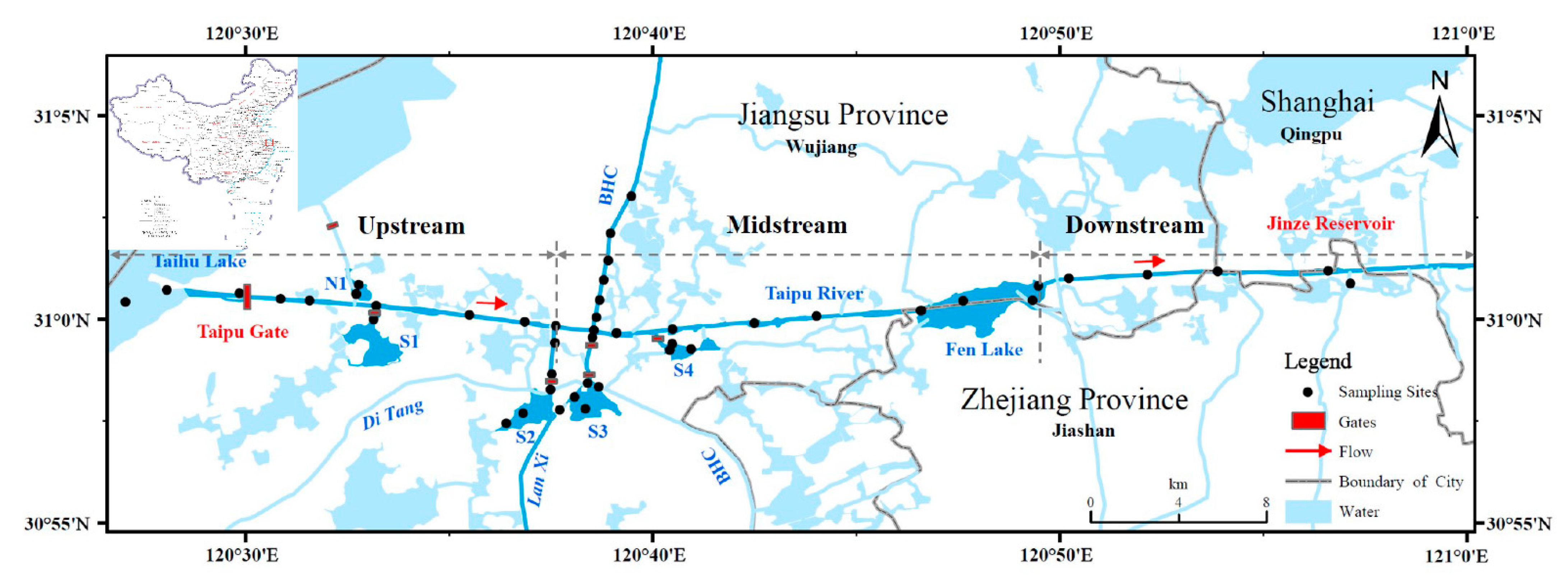
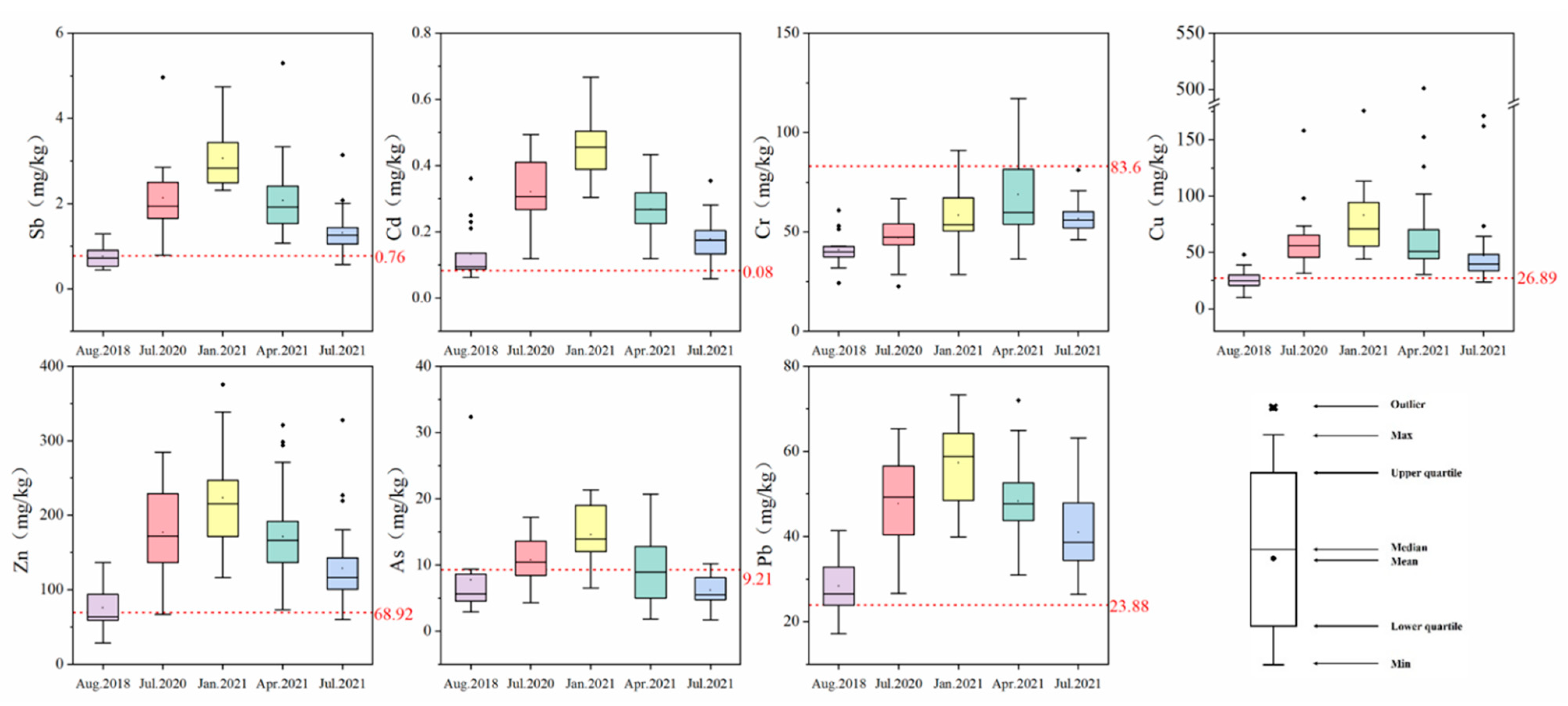
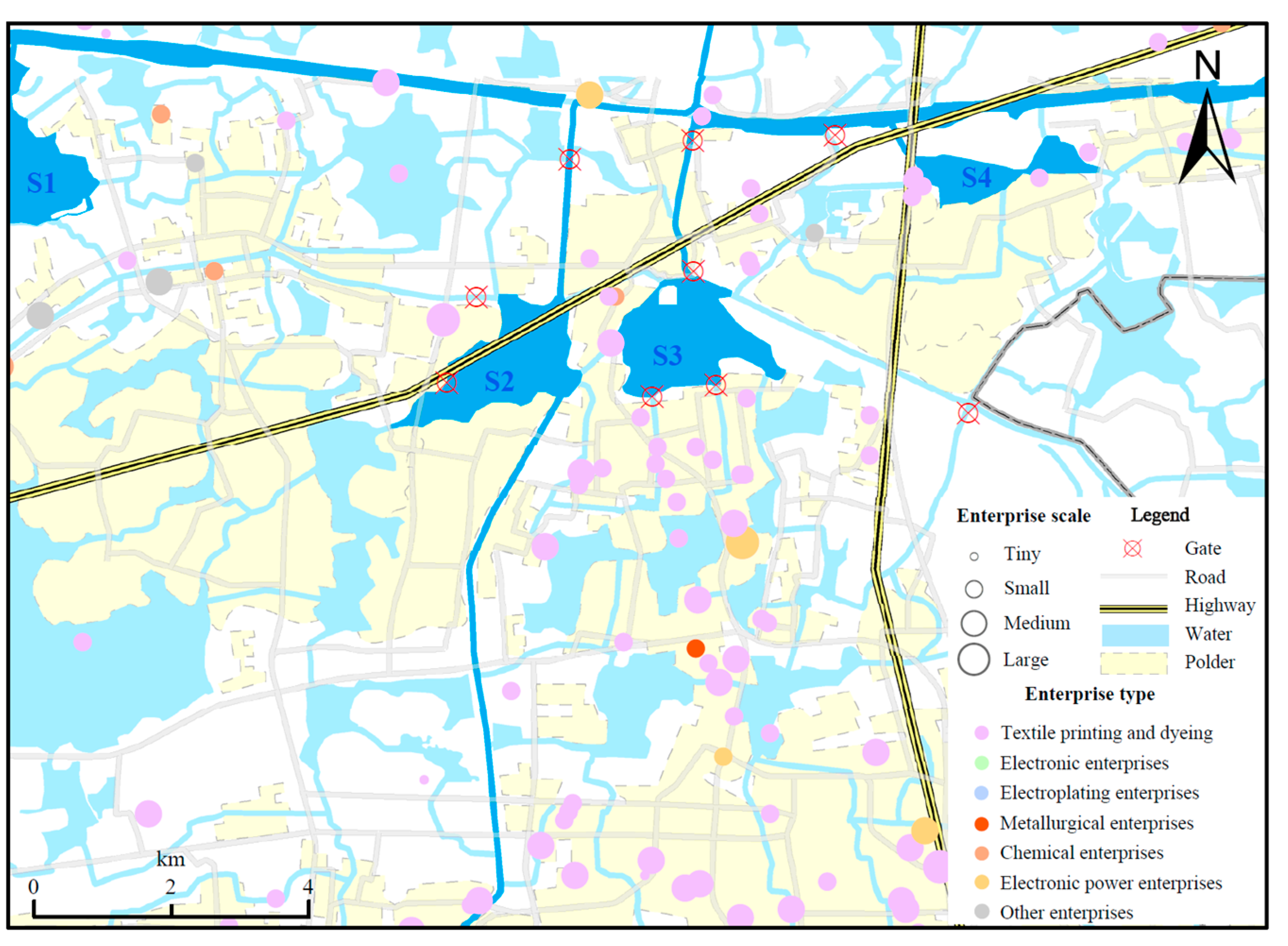

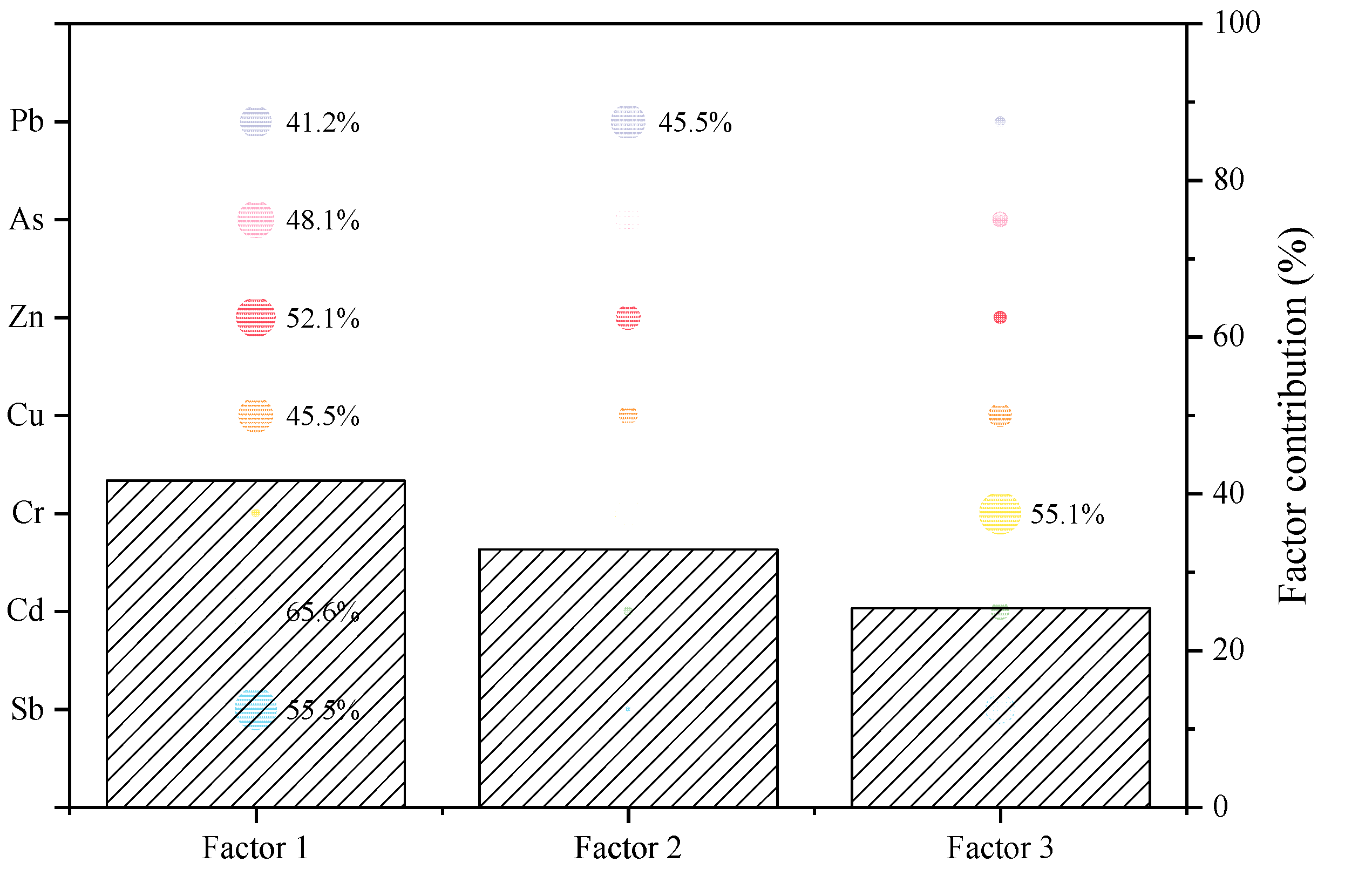
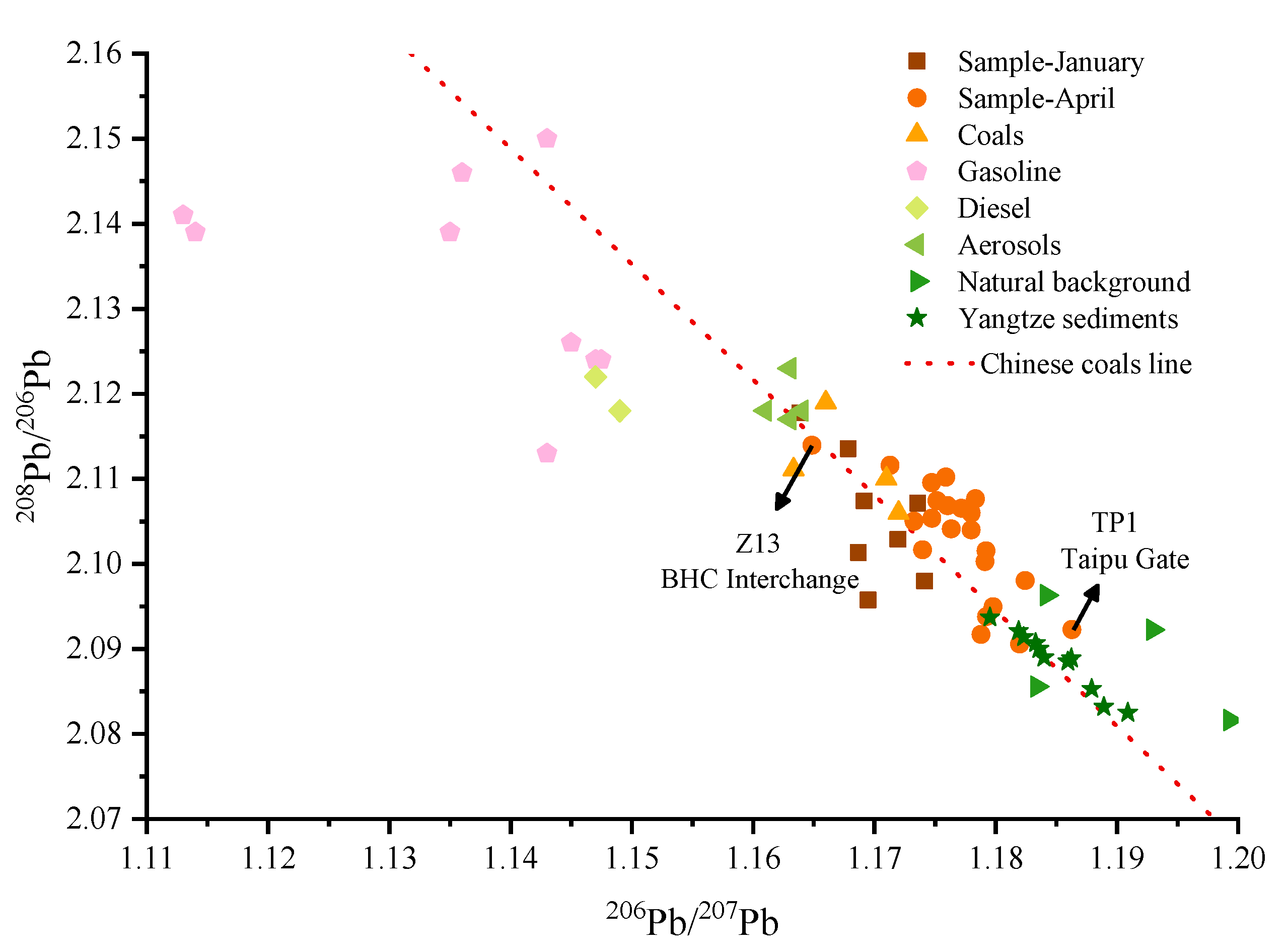
| Sb | Cd | Cr | Cu | Zn | As | Pb | |
|---|---|---|---|---|---|---|---|
| Max | 5.29 | 0.67 | 117.14 | 501.08 | 375.42 | 32.35 | 73.23 |
| Min | 0.44 | 0.06 | 22.58 | 9.83 | 28.52 | 1.72 | 17.18 |
| Mean | 1.83 | 0.26 | 57.36 | 61.12 | 154.75 | 8.97 | 44.86 |
| Median | 1.65 | 0.24 | 55.06 | 47.73 | 142.21 | 8.19 | 44.86 |
| SD | 0.94 | 0.13 | 17.15 | 54.76 | 67.81 | 5.00 | 12.08 |
| VC (%) | 51.38 | 48.75 | 29.89 | 89.60 | 43.82 | 55.73 | 26.93 |
| GB | 0.77 | 0.08 | 83 | 27 | 69 | 9.2 | 23.9 |
| ER (%) | 91.6 | 98.6 | 8.4 | 92.3 | 91.6 | 37.1 | 96.5 |
| Sb | Cd | Cr | Cu | Zn | As | Pb | References | |
|---|---|---|---|---|---|---|---|---|
| Taipu River, China, 2021 | 1.83 | 0.26 | 57.36 | 61.12 | 154.75 | 8.97 | 44.86 | Present study |
| Taipu River, China, 2015 | 7.74 | 0.74 | 87.20 | 62.20 | / | / | 34.90 | [24] |
| Taihu Lake, China, 2018 | / | 0.61 | 68.85 | 35.53 | 109.32 | 16.99 | 29.70 | [3] |
| Taihu Lake, China, 2015 | 2.37 | 0.55 | 82.30 | 32.80 | 109.0 | / | 35.10 | [32] |
| Huangpu River, China, 2018 | 2.80 | 2.20 | 96.30 | 40.20 | 139.7 | 11.30 | 68.60 | [33] |
| The Yellow River, China, 2020 | / | 0.11 | 45.31 | 15.59 | 49.40 | 11.74 | 17.71 | [34] |
| Three Gorges Reservoir, China, 2014 | / | 1.17 | 114.8 | 95.81 | 164.89 | / | 73.92 | [38] |
| Jialu River, China, 2009 | / | 2.93 | 60.80 | 39.22 | 107.58 | 6.31 | 29.35 | [39] |
| The Pearl River, China, 2011 | / | 3.77 | 180.6 | 182.5 | 487.12 | / | 150.61 | [35] |
| Xiangjiang River, China, 2010 | / | 15.0 | 51.99 | 43.01 | 266.57 | 71.10 | [30] | |
| Lianjiang River, China, 2005 | / | 4.10 | / | 1070 | 324.0 | / | 230.0 | [40] |
| Zijiang River, China, 2017 | 36.6 | 3.00 | 67.51 | 34.19 | 141.90 | 31.53 | 35.68 | [41] |
| St. Lawrence River, Canada, 2016 | / | 0.80 | 68.50 | 108.0 | 3035.9 | 8.80 | 58.20 | [36] |
| Nador lagoon, Morocco, 2013 | / | 1.60 | 71.60 | 10.20 | 554.9 | / | 135.0 | [42] |
| Danube River, Germany, 2001 | / | 1.50 | 71.10 | / | 258.0 | 20.10 | 52.5 | [37] |
Publisher’s Note: MDPI stays neutral with regard to jurisdictional claims in published maps and institutional affiliations. |
© 2022 by the authors. Licensee MDPI, Basel, Switzerland. This article is an open access article distributed under the terms and conditions of the Creative Commons Attribution (CC BY) license (https://creativecommons.org/licenses/by/4.0/).
Share and Cite
Yao, Q.; Chen, L.; Mao, L.; Ma, Y.; Tian, F.; Wang, R.; Meng, X.-Z.; Li, F. Co-Effects of Hydrological Conditions and Industrial Activities on the Distribution of Heavy Metal Pollution in Taipu River, China. Int. J. Environ. Res. Public Health 2022, 19, 10116. https://doi.org/10.3390/ijerph191610116
Yao Q, Chen L, Mao L, Ma Y, Tian F, Wang R, Meng X-Z, Li F. Co-Effects of Hydrological Conditions and Industrial Activities on the Distribution of Heavy Metal Pollution in Taipu River, China. International Journal of Environmental Research and Public Health. 2022; 19(16):10116. https://doi.org/10.3390/ijerph191610116
Chicago/Turabian StyleYao, Qinglu, Ling Chen, Lingchen Mao, Yu Ma, Fengyan Tian, Ruijie Wang, Xiang-Zhou Meng, and Feipeng Li. 2022. "Co-Effects of Hydrological Conditions and Industrial Activities on the Distribution of Heavy Metal Pollution in Taipu River, China" International Journal of Environmental Research and Public Health 19, no. 16: 10116. https://doi.org/10.3390/ijerph191610116
APA StyleYao, Q., Chen, L., Mao, L., Ma, Y., Tian, F., Wang, R., Meng, X.-Z., & Li, F. (2022). Co-Effects of Hydrological Conditions and Industrial Activities on the Distribution of Heavy Metal Pollution in Taipu River, China. International Journal of Environmental Research and Public Health, 19(16), 10116. https://doi.org/10.3390/ijerph191610116








